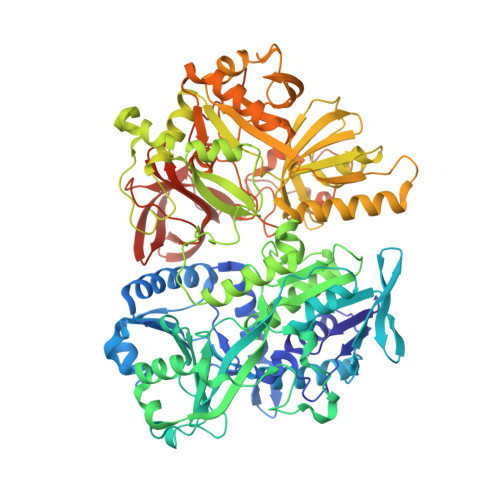An internal reaction chamber in dimethylglycine oxidase provides efficient protection from exposure to toxic formaldehyde.
Tralau, T., Lafite, P., Levy, C., Combe, J.P., Scrutton, N.S., Leys, D.(2009) J Biol Chem 284: 17826-17834
- PubMed: 19369258
- DOI: https://doi.org/10.1074/jbc.M109.006262
- Primary Citation of Related Structures:
3GSI - PubMed Abstract:
We report a synthetic biology approach to demonstrate substrate channeling in an unusual bifunctional flavoprotein dimethylglycine oxidase. The catabolism of dimethylglycine through methyl group oxidation can potentially liberate toxic formaldehyde, a problem common to many amine oxidases and dehydrogenases. Using a novel synthetic in vivo reporter system for cellular formaldehyde, we found that the oxidation of dimethylglycine is coupled to the synthesis of 5,10-methylenetetrahydrofolate through an unusual substrate channeling mechanism. We also showed that uncoupling of the active sites could be achieved by mutagenesis or deletion of the 5,10-methylenetetrahydrofolate synthase site and that this leads to accumulation of intracellular formaldehyde. Channeling occurs by nonbiased diffusion of the labile intermediate through a large solvent cavity connecting both active sites. This central "reaction chamber" is created by a modular protein architecture that appears primitive when compared with the sophisticated design of other paradigm substrate-channeling enzymes. The evolutionary origins of the latter were likely similar to dimethylglycine oxidase. This work demonstrates the utility of synthetic biology approaches to the study of enzyme mechanisms in vivo and points to novel channeling mechanisms that protect the cell milieu from potentially toxic reaction products.
Organizational Affiliation:
Manchester Interdisciplinary Biocentre, Faculty of Life Sciences, University of Manchester, 131 Princess Street, Manchester M1 7DN, United Kingdom.

















